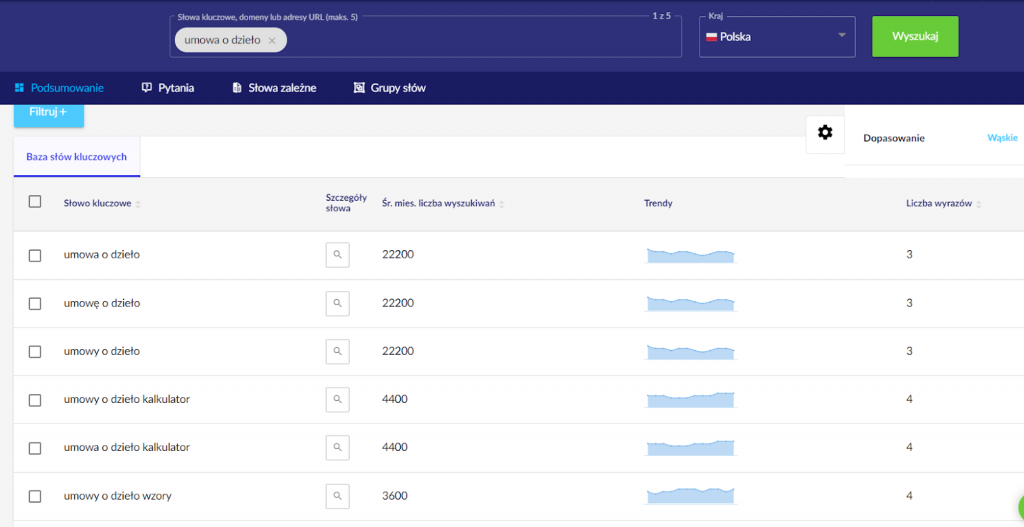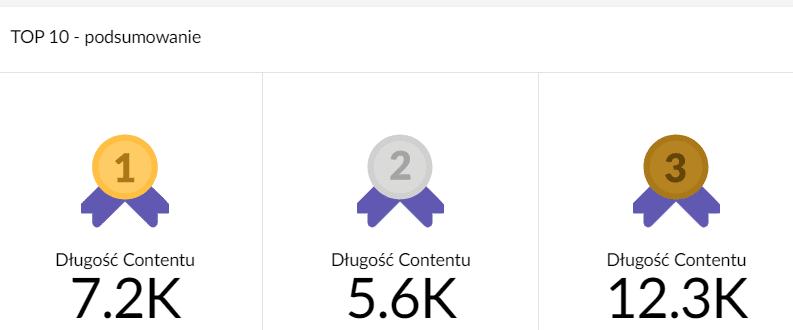GoWork.pl is a website with job ads and employer reviews. We also serve daily labor market information in the tabs: Employee Guide and Blog. Internet users looking for answers to questions such as how to write a resume or cover letter, how much money is earned in various professions or what is changing in terms of employment are increasingly coming across our articles through search engines. We want to continue this trend.
The content team at GoWork.pl currently consists of 10 young, ambitious people. We use many tools, Senuto, however, is the primary one. With its help we analyze SERPs, select keywords and create content plans. About 90 articles are created monthly with the help of Senuto.
SEO is of great importance to us, but for the GoWork.pl team, the priority is the reader: our mission is to help them unravel any, even the most complicated labor law case, support them in their difficulties and motivate them to constantly develop.
How to write SEO texts in the labor market industry?
.
Writing for SEO is a concept that slightly changes meaning over time. The process of optimizing content was different a few years ago, and quite different today. Tools for keyword search and competitive analysis help in creating good texts taking into account changes in Google’s algorithms. One of them is Senuto. How exactly does it work and how does it help with content creation at GoWork.co.uk?
Content for SEO, that is, what kind of content?
.
SEO, i.e. the process of optimizing pages for search engines, is aimed at making a site appear as high as possible in organic results. Taking care of good positions in Google is, of course, much more than just writing: specialists also take care of technical issues related to the website, its architecture or acquiring links. In this article, however, let’s look at the principles of creating SEO-friendly content.
Good texts posted online should provide value both in terms of content (it’s good if they are interesting, credible and answer – asked or unasked – questions of the reader. This involves building authority and trust according to the E.A.T principle), as well as language. This is especially important in the labor market industry, where the credibility and expertise of the texts is crucial.
It is said that “good content will defend itself.” This is of course true, but I would add here that this content should be based on good guidelines, taking into account analysis of competitive content and selection of appropriate keywords.
Good texts in the face of current algorithm changes
.
Over the years, Google has increasingly placed a premium on valuable and well-structured content. Practices such as “stuffing” key phrases not closely related to the topic or placing them in a grammatically incorrect way, as well as texts that do not contribute anything relevant, will not help achieve high search engine positions.
The recently announced tests of a new algorithm called MUM (Multitask Unified Model) allow us to assume that in the future, in creating content for SEO, the relevance of the phrases used in the text to the actual topic will be even more important, as well as answering as many detailed questions as possible.
MUM is heralded as a much more advanced version of BERT technology, which has led to significant reshuffling in search results. So it’s worth taking care of valuable content on your site in advance. How do we do it at GoWork.co.uk using Senuto?
Senuto keyword database: how to use it in content creation?
.
To get the most out of this tool, we at the GoWork.co.uk content team first focused on carefully tracing the functions of the various reports in the Senuto keyword database. The search results are divided into 4 sections:
- Summary, containing all search phrases with their monthly number of searches: both generic and of the long-tail type (depending on whether you are interested in a larger number of phrases loosely oscillating around the main topic or only those closely related to the main keyword, you can choose broad or narrow matching);
- Questions, i.e., phrases in question form useful especially when constructing headlines and post titles;
- Dependent words: in this tab we will find semantically related phrases that are worth using in the text to enrich it in terms of meaning by building a broader context and thus optimize it even better;
- Word Groups: a report useful in terms of saturating content with linguistically related words. By using phrases related to our main keywords not only on a semantic level, but also on a linguistic level, you can enable search engines to understand your text even better.
.
.
How does writing with Senuto at GoWork.co.uk look like in practice?
As an example, let’s use here a very important key phrase for the labor market industry: work contract. If a well-optimized text is to be about this form of employment, we start preparing to write it in the tab: Senuto keyword database by typing the appropriate phrase into the search engine.
1.To begin with, we check whether and in what specific configurations the phrase contract for work is searched by Polish Internet users. After clicking the search button, we get a list of complementary words and phrases along with the volume of searches:

The tool suggests as many as several hundred phrases, some of them quite loosely related to the topic of interest. In this case, when planning the text for SEO, I go to narrow match, where we find fewer of them, but more closely related to our main phrase:

Sizing works well for less popular phrases, and the suggestions from this report are also worth considering in the context of new content that links thematically to the currently optimized site.
2 Now it’s time to prepare a list of phrases that should be included in the article. Generated in Senuto, the list is almost ready for a copywriter’s brief. Based on it, I will prepare, for example, the following guidelines for a text about a work contract:
| Main words: | Questions: | Dependent words: |
| work contract, work contract template, work contract tax, work contract 2021, bill to work contract, work contract zus, work contract vs. contract of mandate, work contract with transfer of copyrights, notification of work contract to zus, tax on work contract, work contract examples | works contract, works contract template, works contract tax, works contract 2021, bill to works contract, works contract zus, works contract vs. contract of mandate, works contract with transfer of copyrights, notification of works contract to zus, tax on works contract, works contract examples | what is a works contract, works contract information, works contract parties, form of works contract, how many works contracts can be concluded, works contract description, works contract content, what can you do for a works contract, elements of a works contract, how long can a works contract last |
.
3 Based on the main phrases and questions, the copywriter will construct headlines and plan the content. Typically, when writing for SEO, I recommend using the phrases with the highest monthly search volume for the title (H1). H2 and H3 headings can also consist of less popular words, phrases from the so-called “long tail” and questions: the more docking phrases, the better. The number of headings and characters used in the content may depend on the results of the SERP analysis in Senuto – I explain this aspect in more detail later in the article).
4. text writing is based on the use of previously prepared guidelines. I rate the reports coming from Senuto against other SEO tools as relatively easy to use, because the keyword base is broad and based on NLP (Natural Language Processing: natural language processing technology). As a result, the words from the brief can easily be put into a sentence without creating an impression of artificiality, and the text itself reads quickly and easily.
5. when publishing the text, we also take care to properly saturate the meta tags with keywords, so create unique meta title and meta description containing the most important phrases from Senuto, on which we position the sub-page.
Other useful features: phrase popularity graph and quick hints
.
A noteworthy feature in Senuto’s keyword database is a trend graph showing the popularity of a phrase over time:

Looking at the chart, we can assess whether particular keywords will be searched for all year round, or whether they are characterized by seasonality. Depending on this, we decide to publish the article at a specific time: for example, before the vacations if the topic is particularly popular in July or August, or create it at any time if it is a so-called evergreen topic.
In case it takes a long time to collect data for the main keyword database reports, it is also recommended to go to the Quick Hints report. It presents words related to the phrase typed into the search engine without the monthly number of searches. It is sometimes helpful when results are needed quickly, and in our experience, the phrases contained therein sometimes complement the words accumulated in the main view and go beyond them, which helps optimize the article even better.
Senuto SERP analysis, a way to stay ahead of the competition
.
Let’s assume that the website is technically properly optimized, the content plan prepared flawlessly, and the brief with keywords for the copywriter is already ready, and proper internal linking has been taken care of in advance. What else is needed to write a text that takes into account principles of SEO copywriting? Of no small importance is its length and the way it is constructed.
In order to get ahead of competitive posts on a similar topic, the GoWork.co.uk team performs a detailed analysis of the SERP (Search Engine Results Page – a page in Google with search results for a given keyword). It can be done manually, but SEO tools help save time and automate the whole process a bit.
Senuto’s Selected SERP Analysis shows the most important information about the pages that make up the top 10 results: their length given in number of characters with spaces, number of h1, h2 and h3 headings and meta title. The tool also presents the average number of characters of all top results:
 .
.
A common question in this context is whether writing an article longer and with more headlines than your competitors guarantees high search engine rankings. My answer is (as usual in SEO): it depends.
Of course, the longer and more comprehensive the topic of the text, the greater the chance of first place in Google results, but this is not an absolute rule. Such a text must also be adequately saturated with keywords and related phrases, and should not be lengthened by force. So-called pouring water will certainly not contribute to success. And since many other SEO-related aspects also matter, a well-written for SEO text may or may not appear high in Google results.
However, making sure it is optimized as well as possible is the best way to have a chance at it: the GoWork.co.uk Blog and Employee Guide team has proven this more than once.
Summary
.
We use the following steps in planning and creating SEO-optimized content with the Senuto tool:
- select a topic based on trends and search volume in the Keyword Database tab,
- create a brief containing the main keywords, questions and related words taken from relevant reports,
- construction of title, headings and meta tags containing keywords,
- Determination of minimum text length and number of headings based on SERP analysis,
- writing the content taking into account the prepared guidelines,
.
.
.
.
.
 Anna Michniewicz
Anna Michniewicz